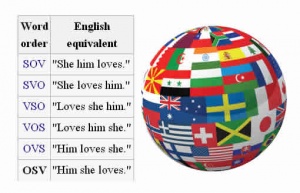Difference between revisions of "Language/Multiple-languages/Grammar/Various-word-orders-in-various-languages"
| Line 39: | Line 39: | ||
|- | |- | ||
|Persian | |Persian | ||
|.<span style="color:red">او</span> <span style="color:green">خواهد رفت</span> | | style="text-align:right;" |.<span style="color:red">او</span> <span style="color:green">خواهد رفت</span> | ||
|.<span style="color:red">من</span> <span style="color:blue">یک ساختمان</span> <span style="color:green">را می بینم</span> | | style="text-align:right;" |.<span style="color:red">من</span> <span style="color:blue">یک ساختمان</span> <span style="color:green">را می بینم</span> | ||
|.<span style="color:red">شما</span> <span style="color:violet">به او</span> <span style="color:blue">یک قلم</span> <span style="color:green">دادید</span> | | style="text-align:right;" |.<span style="color:red">شما</span> <span style="color:violet">به او</span> <span style="color:blue">یک قلم</span> <span style="color:green">دادید</span> | ||
|- | |- | ||
|Turkish | |Turkish | ||
Revision as of 14:08, 22 January 2019
This lesson is about word orders, which can be mainly divided into six types, with smaller differences inside each type.
S represents subject, O represents object, V represents verb.
SOV and SVO take the most propotions, each accounting for about 2/5.
There can be more than one order in a language, the listed are just the most common cases.
Note that in some languages the pronouns are omitted. The person is indicated by conjugation.
Example sentence 1 has a subject, a verb.
Example sentence 2 has a subject, a verb, a direct object.
Example sentence 3 has a subject, a verb, a direct object, an indirect object.
| SOV language | example sentence 1 | example sentence 2 | example sentence 3 |
|---|---|---|---|
| Hindi | वह जाएगी। | मुझे एक इमारत दिखाई देती है। | तुमने उसे कलम दे दी। |
| Japanese | 彼女が行きます。 | 私は建物を見る。 | あなたは彼にペンを与えた。 |
| Korean | 그녀가 갈거야. | 나는 건물을 본다. | 당신은 그에게 펜을 줬다. |
| Persian | .او خواهد رفت | .من یک ساختمان را می بینم | .شما به او یک قلم دادید |
| Turkish | O gidecek. | Bir bina görüyorum. | Ona bir kalem verdin. |
| SVO language | example sentence 1 | example sentence 2 | example sentence 3 |
| Dutch | Ze zal gaan. | Ik zie een gebouw. | Je gaf hem een pen. |
| English | She will go. | I see a building. | You gave him a pen. |
| Esperanto | Ŝi iros. | Mi vidas konstuaĵon. | Vi donis al li plumon. |
| French | Elle ira. | Je vois un bâtiment. | Vous lui avez donné un stylo. |
| German | Sie wird gehen. | Ich sehe ein Gebäude. | Du gabst ihm einen Stift. |
| Greek | Θα πάει. | Βλέπω ένα κτίριο. | Του έδωσες ένα στυλό. |
| Italian | Lei andrà. | Vedo un edificio. | Gli hai dato una penna. |
| Mandarin Chinese | 她會去。/她会去。 | 我看到一座建築物。/我看到一座建筑物。 | 你給他一支鋼筆。/你给他一支钢笔。 |
| Polish | Ona pójdzie. | Widzę budynek. | Dałeś mu długopis. |
| Portugese | Ela vai. | Eu vejo um prédio. | Você deu a ele uma caneta. |
| Russian | Она пойдет. | Я вижу здание. | Вы дали ему ручку. |
| Spanish | Ella irá. | Veo un edificio. | Le diste una pluma. |
| Ukranian | Вона піде. | Я бачу будівлю. | Ти дав йому ручку. |
| Vietnamese | Cô ấy sẽ đi. | Tôi thấy một tòa nhà. | Bạn đưa cho anh một cây bút. |
| VSO language | example sentence 1 | example sentence 2 | example sentence 3 |
| Filipino | Pupunta siya. | Nakikita ko ang isang gusali. | Binigyan mo siya ng panulat. |
| Irish | Beidh sí ag dul. | Feicim foirgneamh. | Thug tú peann air. |
| Welsh | Bydd hi'n mynd. | Gwelaf adeilad. | Rhoddodd eich ysgrifbin iddo. |
| VOS language | example sentence 1 | example sentence 2 | example sentence 3 |
| Malagasy | Handeha izy. | Nahita tranobe iray aho. | Nomenao penina izy. |
| OSV language | example sentence 1 | example sentence 2 | example sentence 3 |
| OVS language | example sentence 1 | example sentence 2 | example sentence 3 |
More information
Wikipedia article:
https://en.wikipedia.org/wiki/Word_order
Lists of languages sorted by word order:
http://lingwiki.com/index.php?title=List_of_SOV_Languages
http://lingwiki.com/index.php?title=List_of_SVO_Languages
http://lingwiki.com/index.php?title=List_of_VSO_Languages
http://lingwiki.com/index.php?title=List_of_VOS_Languages
http://lingwiki.com/index.php?title=List_of_OSV_Languages
http://lingwiki.com/index.php?title=List_of_OVS_Languages
